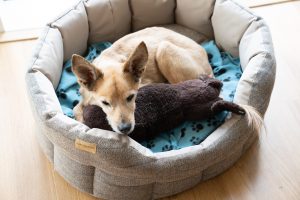Prep Your Pets for Post-Pandemic Life
If you're heading int the office, are your pets ready?
 During the past year, many of us have looked for comfort and connection during lockdown. And for more than 12 million households that came in the form of a new pet, according to the American Pet Product Association.
During the past year, many of us have looked for comfort and connection during lockdown. And for more than 12 million households that came in the form of a new pet, according to the American Pet Product Association.
These family additions, dubbed “Pandemic Pets,” have been strong support systems and companions during a very uncertain year. But now that offices are reopening and normalcy is slowing returning, it’s time to reverse the roles and ensure your pets are prepped and ready for those long days at home … without you.
So before you slip back into your work clothes and mentally prepare to make the commute back to the office, check out these tips from local pet owners and pet experts for best practices on keeping your furry family members happy, healthy and adjusted to the new normal.*
*Note: Our optimism got the better of us last summer when we published “The Dog Days of Summer Are (Not Completely) Over” in our August 2020 issue. Find more tips in that article tagged below.
Start Slow
After spending every waking minute with your pets by your side, it might be time to restore a sense of independence. For your pet, that is.
 With pet adoptions surging in 2020, many families became the proud owners of rescue cats and dogs and were able to keep an eye on them during the work-from-home year.
With pet adoptions surging in 2020, many families became the proud owners of rescue cats and dogs and were able to keep an eye on them during the work-from-home year.
But now for those beginning the transition of leaving their pets home alone, keep in mind that many rescues have a history of being left behind by previous owners. Your rescue may struggle with being left alone by you for long periods, out of fear of being abandoned again.
“Broadly speaking, [rescues] need to be watched for at least the first month,” says Zack Miller, local rescue dog owner. “A lot of them are used to being on the streets, so they tend to be more of a flight risk.” Beginning the process of leaving your rescue pet home alone can trigger past abandonment issues, so it’s important to keep a close eye on them during the transition and adjust based on their reactions.
 To combat these anxieties, encourage your pet to spend time in their own bed or outside in a fenced yard to help break that attached-at-the-hip behavior. Use this technique as a steppingstone to help get your pet used to being by themselves while still being close enough to help if anything goes awry.
To combat these anxieties, encourage your pet to spend time in their own bed or outside in a fenced yard to help break that attached-at-the-hip behavior. Use this technique as a steppingstone to help get your pet used to being by themselves while still being close enough to help if anything goes awry.
Nichola Redmond, Site Director at Main Line Animal Rescue, recommends a gentle transition. “Some dogs haven’t had to experience the ebb and flow of typical everyday life,” she says. “To help them adjust, start by establishing where your pet is going to stay when you’re gone and give them time to get familiar with the area.”
If your dog normally spent time in a crate or behind a pet gate while you were away at work, re-introduce the space by having them take their naps there. “Just make sure the crate is large enough for them to stand, turn around and stay comfortable for extended periods of time,” reminds Redmond. The crate should look more like a dog den rather than a pet prison. Include some toys for your pet to chew on, plus food and water to keep them fed and hydrated throughout the day.
Create a schedule
For some of us, our routine has changed drastically. Family mealtimes may have been pushed back or more walks with pets were part of the daily schedule to avoid being stuck inside all day. Whatever the old pandemic normal, it’s time to get your pet’s routine ready for the new normal.
 For pets that joined your family during the pandemic, your new work schedule will be completely new rather than simply going back to normal. If you can, start even more slowly by changing one thing at a time to help your pet adjust.
For pets that joined your family during the pandemic, your new work schedule will be completely new rather than simply going back to normal. If you can, start even more slowly by changing one thing at a time to help your pet adjust.
If your pet’s eating schedule became more relaxed during the past year, start introducing set feeding times that will continue when you return to work. “Using an automatic feeder, we’ve set up a specific lunch time, so our dog has something to look forward to when we’re not around,” says Miller.
Resist the urge to walk or play with your pets during hours you would normally be away. Instead create scheduled play times and walk times for before and after work. Throwing the ball around in the backyard or going for a nice long walk before heading out the door will help burn some of your pet’s energy, so they’re tired out before you leave.
No matter how hard it may be, especially with those puppy dog eyes peering up at you, sticking to a schedule will benefit both your pet and you in the long run.
Practice Makes Perfect
Most jobs will give you some notice before you must return to the office. Don’t delay the inevitable. Instead, use this valuable time to help train your pet for post-pandemic times.
 Start by leaving your home for short periods, even just 15–30 minutes. Then gradually increase your away-time each time you go out. If your neighbors are close by, alert them of your practice sessions in case of any excessive barking or other mischief.
Start by leaving your home for short periods, even just 15–30 minutes. Then gradually increase your away-time each time you go out. If your neighbors are close by, alert them of your practice sessions in case of any excessive barking or other mischief.
Make your departure ritual short and simple—the bigger deal you make of leaving, the more anxiety your pet will have. Animals can pick up on their owner’s emotions, so the calmer and more relaxed you are, the better chance your four-legged friend will be too.
Pets that were around for your pre-pandemic routine may have an easier time adjusting. Animals have a remarkable ability to pick up on details in your daily schedule. So, if you had a set routine before you left for work, start introducing those rituals again when you leave for shorter excursions.
Dr. James Paine, Owner and Veterinarian at Applebrook Inn, urges owners to trust their gut. “What’s difficult about predicting anxiety with pets is that it can happen suddenly,” he says. “Keep an eye out for any subtle changes in your pet’s behavior so you can catch them early on.”
A helpful way to discover pet behavior while you’re gone is to invest in a camera like the Furbo Wifi Dog Camera. Set it up before you leave, and watch for signs of anxiety like barking, shaking, pacing and chewing.
If your pet can self-soothe in the first 5–10 minutes, they’ll most likely be fine during the transition period. But if your pet continues to show signs of anxiety during the entire time you’re gone, it might be helpful to contact a professional for extra help (see sidebar).
Remember, this transition will come with a learning curve for both you and your pet. “This process is time consuming,” says Dr. Paine. “But it will help you discover what your pet is comfortable with.” Take their reactions into consideration and adjust the routine until you figure out something that works for both of you.
Treats and Tricks
Another technique to help remove anxiety and stress associated with your departure is with treats and tricks.
 If your dog is used to having background noise in the house, consider leaving on the TV or playing music to help distract them. “I’ve noticed that classical music helps my dogs stay calm, so now I turn it on before I leave,” says Katherine Baker, local pet owner.
If your dog is used to having background noise in the house, consider leaving on the TV or playing music to help distract them. “I’ve noticed that classical music helps my dogs stay calm, so now I turn it on before I leave,” says Katherine Baker, local pet owner.
Another option is giving your pet small treats and toys to play with before you leave. The Miller family lays all their dog’s toys on the floor to help keep him occupied throughout the day.
And Dr. Paine suggest using food distributing treats that have longevity, like dog-friendly puzzle toys. Try using the Kong toy filled with peanut butter or kibble and let your pet figure out how to get the snack out.
Another low budget option is a white bone that can be chewed on for hours at a time. Or the high budget option is the Furbo Wifi Dog Treat camera that lets you schedule times for treats to be dispensed—all from your phone. Plus there’s the added bonus of keeping an eye on your pet with the built-in camera.
And finally whenever you return home, praise your pet for their good behavior and let them know just how much you missed them with some extra treats and kisses.
With these tips in mind, your pet’s anxiety will be manageable in no time and you’ll both be able to enjoy this next phase of life together.
Helping Paws
If you find your pet needs a little extra help getting back on track, check out more advanced ideas for a smoother transition.
DOG WALKER: Notice your pet getting antsy halfway through the day? Consider hiring a dog walker for mid-day walks to burn off some energy.
DOGGY DAY CARE: For dogs that need a bit more supervision, try doggy day care, offering playtime, supervision, and care for your pets while you’re at work. A bonus is more social time with other dogs and humans.
PET-FRIENDLY OFFICE: Pets at work may sound too good to be true but pet-friendly offices are on the rise. Check your company policy on pets. Maybe you and your furry friend can make the commute together.
OUTSIDE TIME: Give your pet some outside freedom (in a fenced yard) with the Petsafe Electronic Smartdoor. Your pet wears the Smartkey on their collar and the door reads the key’s signal to unlock the door whenever your pet is ready to go in or out.
HIGH-TECH TOY: Keep your pet entertained with the iFetch Mini Automatic Ball Launcher. Once the launcher is plugged in all you have to do is drop the ball in and let the machine toss it for you. Soon your dog will learn how (or you can teach your pet) to drop the ball in him or herself for totally independent play.
TRAINER: Re-training your pet can feel like an overwhelming task but luckily there are professionals willing to help. Hire a trainer for more personalized tips and best practices for communicating with your pet.
ANIMAL PSYCHOLOGIST: Some pets might have more anxiety than others or struggle with self-soothing. In this case, reaching out to an animal psychologist to discuss medication or other tools will help your pet and peace of mind.
